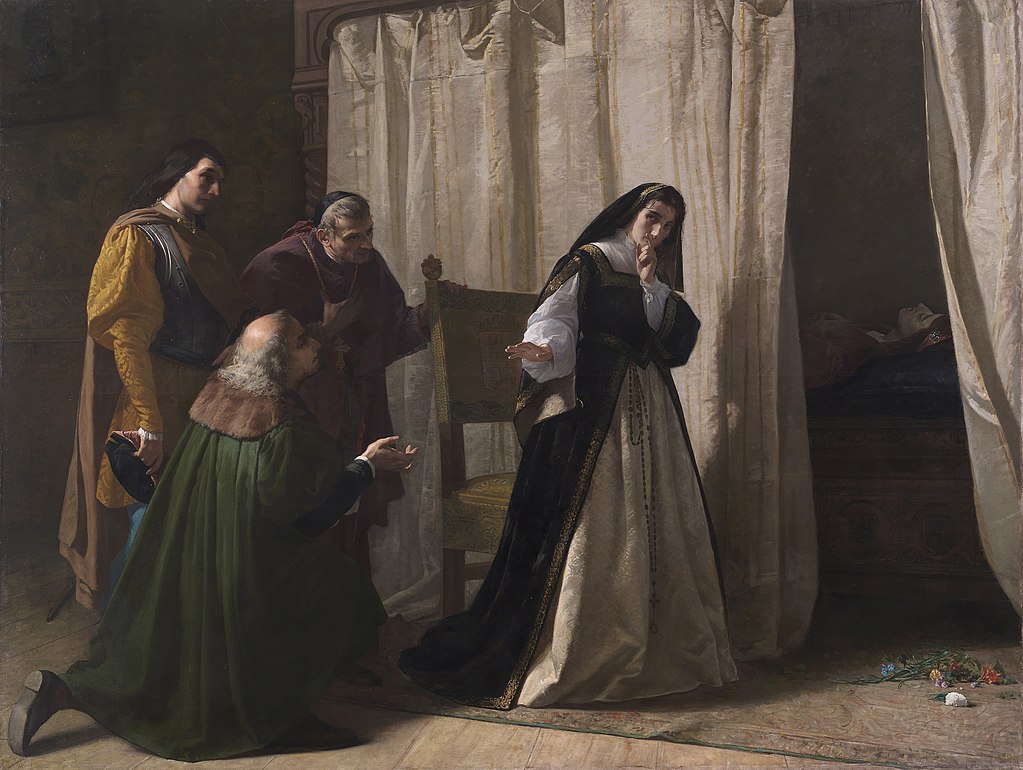Joanna of Castile, The Madwoman
Joanna of Castile, madly in love with her husband, Philip of Burgundy (Philip I of Castile, the handsome), became excessively jealous of him, and her jealousy drove her almost mad.
During her youth, she appears as an intelligent, educated and highly sensitive person. It was not until her marriage to Philippe le Beau that the first allusions to a mental imbalance appeared. His troubles began during the visit of the prior of Santa-Cruz on the orders of Queen Isabella of Castile, who demanded a report on the moral and religious environment of her daughter. The prior submits a severe report, describing the icy reception that the princess would have given him, described as sluggish, passive and withdrawn behind her flamboyant husband, began to see other ladies on the side.
The young woman turns out to be totally captivated by the beauty of her husband, in love to the point of forgetting her own responsibilities.

Joanna the Crazy and Philip the Handsome, painted in Flanders around 1500. Master of Affligem, Public domain, via Wikimedia Commons
Short biography of Joanna the Mad
Daughter of the famous Catholic Kings, Ferdinand II of Aragon and Isabella of Castile, and mother of Charles V, Joan I of Castile is nicknamed Joan the Mad by historical tradition. Princess Jeanne is educated in the religious tradition by her mother and no sign of madness is carried over until her marriage to Philip of Habsburg, nicknamed Philip the Handsome. When she married Philippe at the age of 18, she took part in the alliance with Austria and against France.
Together, they have several children including Charles, future Charles V who becomes King of Spain and Emperor of the Holy Empire. But this arranged marriage turns into passion for the young Jeanne who dedicates to her husband a love described in the sources as unconditional. This is where the first hints of dementia arise. Indeed, abandoned by her unfaithful husband, she had several fits of jealousy and became more and more tolerant of heretics. In the troubled context of the Spanish Inquisition, several sources testify to the cruelty of Isabella of Castile towards her daughter. Jeanne is interned by her mother, but also her husband, her father and later her son, undergoing physical and mental torture.
When Isabella of Castile died in 1504, Joan I and Philip of Habsburg ascended the throne of Castile. However, word spread of the queen’s inability to govern. The will of Isabella of Castile provides that the regency of the kingdom returns to her husband Ferdinand II in the event of Joan’s inability to reign. Jeanne having left the power to her husband, Ferdinand II and Philippe de Habsbourg clash, then combine.
Philip of Habsburg died suddenly in 1506 and Ferdinand was left as sole ruler of the two kingdoms. When he died on January 25, 1516, Joan inherited, in addition to Castile, the Kingdom of Aragon. She is again interned by her son, Charles V, and passes her powers to him. Jeanne’s madness is not a certainty, she mainly served the political games of the time. However, a proven case of schizophrenia due to inbreeding was discovered among his ancestors. It is therefore possible that Jeanne herself was affected by the disease. She dies at the age of 76. The tragic fate of Jeanne la Folle is the subject of many representations, in books and films.
Conspicuous (noticeable) behavior
Long before she was called “loca” – that means “foolish” rather than insane – Johanna had aroused astonishment and rejection by her behavior in her own family and at court, especially in relation to her husband Philip. Instead of accepting the dynastic marriage partner chosen by her parents for political reasons, she fell in love with Philip and showed this love demonstratively, regardless of the Spanish court ceremonies. Instead of discreetly ignoring the countless infidelities of her husband, she openly showed her jealousy and amazed by her helpless attempts to keep women away from him.
Her behavior after the sudden death of her husband on September 25, 1506 in Burgos met with complete incomprehension, as she showed excessive grief and traveled through Castile for months with the coffin to bury Philip in the city of Granada, which her parents had conquered in 1492. What is overlooked is that she wanted to fulfill her husband’s last wish and that the delay in the journey was due to her father deliberately blocking Philip’s burial in Granada.
Decades of internment and the accompanying isolation and sometimes inhumane treatment by the guards had serious negative effects on her psyche. There are only a few objective records of this, some of which report contradictory reports of extensive neglect and mental absence, but occasionally also of normal and undisturbed behavior.
Controversy over her mental health
The official version in the 16th century was that Queen Joan had been removed from the throne due to her incapacity due to mental illness. It has been written that he suffered from melancholia, major depressive disorder, psychosis, schizophrenia inherited. There is debate over the diagnosis of mental illness, given that his symptoms were worsened by forced confinement and submission to others.
The dementia of Queen Joanna (1867), by Lorenzo Vallés. Prado Museum (Madrid). Lorenzo Vallés, Public domain, via Wikimedia Commons
It has also been speculated that he may have inherited the disease from some of his maternal relatives, as his maternal grandmother, Isabel of Portugal, Queen of Castile, suffered the same during her widowhood when her stepson exiled her to the castle of Arévalo, in Ávila. Gustav Bergenroth was the first, in the 1860s, to find documents in Simancas and other files showing that the so-called Juana la Loca had in fact been the victim of a conspiracy led by her father, Ferran and later confirmed by his son Carlos.
Sources: PinterPandai, Tudor Society, Britannica
Photo credit (main picture): Marquard Wocher, Public domain, via Wikimedia Commons




